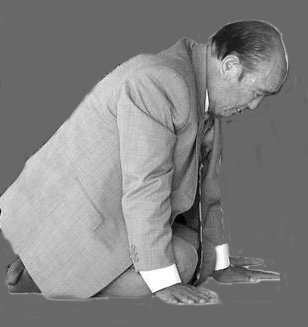While seeking for absolute love, you should not have consciousness of self. (279:146, August 4, 1996)
If we could totally subjugate our body, if our actions were always in conformity with our will, then we would not need religion. Jesus came in order to correct the disunity between the mind and the body. This is also the purpose of the Buddha’s teaching that we should return to the state of nothingness—the zero point. If the mind and body are united, you do not feel [any distinction]. Why should we return to a state of emptiness? It is so we may experience Being. In a state of emptiness, the zero point, there emerges a counterpart with whom you can be in total harmony. Hence, at the zero point you can experience Being one hundred percent. (256:212, March 13, 1994)
God dwells in the ‘king zero point.’ Since God has such a nature, to meet Him you must become even lower than zero. Then you must guard that king zero point. The king zero point is like the mind, and as the flesh surrounds the mind, you should surround and protect the zero point. Have you reached the state where you can guard the zero point? Can you go even lower than the zero point? This is what Buddhist meditation is about—to search the God-like mind for the deepest point. (230:134, May 1, 1992)
The [self-centered] ego has nothing to do with the ideal of creation. Therefore, we should completely deny ourselves. In order to find the true self, we should place ourselves at the zero point. That is the only place where we can be totally united in mind and body.
When God created us, He was in a state of total mind-body unity. He was in a state of total self-giving, with absolute love and absolute faith. God had no space to think of His own benefit or situation. Herein lies the origin of love: it is a state of one hundred percent giving and living for the sake of others. Where do you think you can find your true self? You find it by practicing a life of true love, always living for the sake of others.
If you dwell at the zero point—denying yourself while living for the sake of your family, all humankind throughout the world, and God—you will find your true self without doubt. It is our inevitable destiny to do so as we walk the path of restoration, which leads to salvation. (356:301-02, October 21, 2001)
Although we yearn for God and seek to love Him as the Subject of our faith, our experiences of Him are vague and indistinct. We still wonder, “Where can we find God?” Although He is definitely present, we cannot perceive Him with the certainty that we perceive things with our five physical senses. How, then, can we see God? We do not begin by looking at God, but rather by looking into ourselves.
When we look into ourselves, we find that we exist as mind and body. We should not focus on the body, but look into our mind.
Among a thousand fallen people, their fundamental nature may be the same, but each one has a different mind, a different personality each with different qualities.
When drawing a circle, you first draw a horizontal line and then a vertical line. From the point where they intersect, you draw the circle around it, starting from one degree, two degrees, and finally covering all 360 degrees. The horizontal line and the vertical line determine a 90-degree angle. How, then, do we make our mind a perfect circle? Depending on their personalities, each person draws their horizontal line in a different place. Just as our faces are different from one another, our inborn natures are different.
When drawing our circle through 360 degrees, we begin from zero degrees and trace it based on that standard. However, if the baseline of our minds is not properly fixed, we will not have the proper standard for measuring the degrees of the circle. Indeed, the baselines of people’s minds are not the same. Why? As people’s faces, interests and feelings differ, they each draw their horizontal and vertical lines in a different way.
How, then, can you form a circle covering all 360 degrees? You should find the zero point. Where is your zero point? Everyone has one. It is within yourself, within the core of your heart—there you will find it. When you draw a horizontal line from the zero point, you can properly fix the vertical line perpendicular to it.
We are to stand as object partners before God, our Subject Partner. Surely He has endowed human beings with a base to respond to Him as object partners. Therefore, upon the base of the horizontal mind, we should find the vertical direction, the true perpendicular. Surely there must be one.
You see the horizon in two dimensions, but if you try and estimate the perpendicular your measure could easily be off the mark. How can you find the accurate measure? If your horizontal is too high you must lower it; if it is too low you must raise it, to fix it at the zero point.
In an electrical power plant there are many meters, and each one is calibrated to a zero point. That neutral point must be set properly in order to adjust the positive and negative voltages and to measure the power levels. We, too, must accurately calibrate our zero point.
Where is our zero point located? It is a position that exists but seemingly does not exist. People who practice Zen meditation say that they attain the state of ‘no-self.’ That is what I am talking about. We should reach that spiritual standard, the zero point state. Once we attain it, our horizontal standard will become responsive to all things. (76:125)
